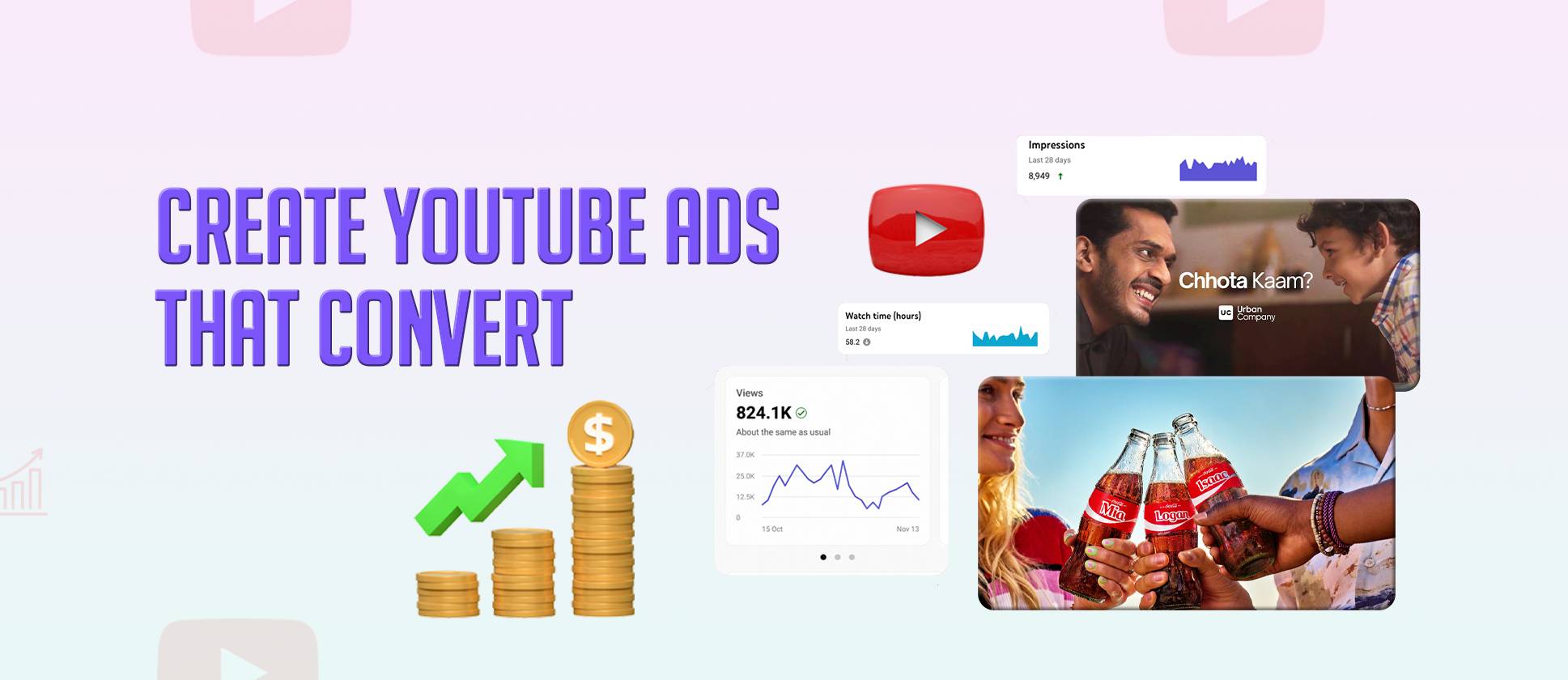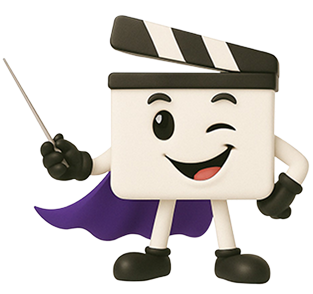Quick Summary
TL;DR: To create effective YouTube ads, start with strong scripts and careful editing. Make sure you have clear calls to action. Capture attention and connect with your viewers to encourage them to take action. Know your audience and customize your content for different formats to increase engagement and conversion rates. #tldr
- Core Principles:
Attention → Branding → Connection → Direction → Hook → Script Flow → Editing Pace → CTA Clarity
- Key Areas: Audience & Intent → Scriptwriting with ABCD Formula → Hook & Message Crafting → Editing for Impact → YouTube Ad Formats → Optimization & Testing → Future AI Trends
- Tools: Adobe Premiere Pro, Final Cut Pro, CapCut Pro
- Main Takeaway: Effective YouTube ads combine storytelling, precise editing, and strategic CTAs. Hire ShortVids for full-service editing.
To create effective YouTube video ads, focus on four key principles: attention, branding, connection, and direction. Start by telling a story that connects with your audience. Carefully edit each frame to keep viewers engaged. Today, brands and creators are learning how to master this skill to drive conversions, not just clicks. Statista reports that YouTube is a key player in digital advertising, reaching over 2.5 billion active users worldwide. With such a large audience, every second of your ad must be purposeful.
In this blog, we will cover how to write YouTube ads that grab attention, edit them effectively, and combine storytelling, sound, and structure to convert that attention into action. To make your ads emotionally engaging, explore how video storytelling helps shape powerful narratives that drive viewer response.
Why Writing and Editing Matter to Create YouTube Ads
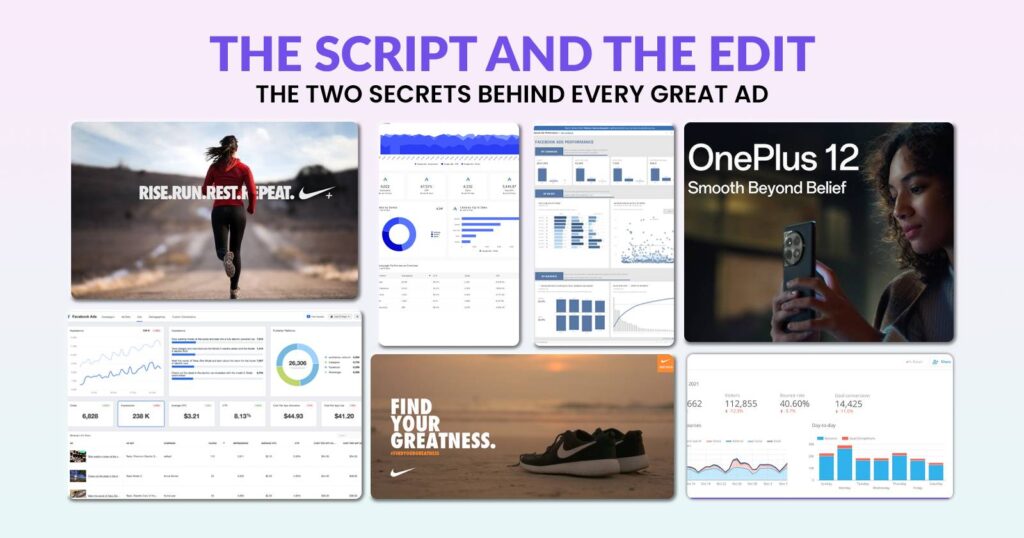
Most creators spend hours perfecting the visuals of their ads, but overlook the two elements that actually shape performance, writing and editing. A powerful script gives direction and emotion to your ad, while editing determines how that message feels in motion. Together, they influence more than 80% of how effectively your video performs.
Viewers decide in seconds whether to keep watching or skip. The first five seconds of your ad, called the hook, are very important. They matter just as much as the offer. A good story catches people’s attention. A clear message tells them what to do next, like buy something. When both parts work together, the ad feels easy to understand and convincing.
According to HubSpot’s Video Marketing Statistics 2025, over 73% of marketers say well-written and tightly edited videos perform significantly better in engagement and click-through rates.
| Element | Why It Matters | Impact on Ad Performance |
|---|---|---|
| Hook (first 5 seconds) | Captures attention | Increases retention rate |
| Script flow | Keeps the audience engaged | Improves watch time |
| Editing pace | Matches emotion and tone | Boosts conversion |
| CTA clarity | Directs viewer action | Raises CTR |
The Formula to Create the Perfect YouTube Ads
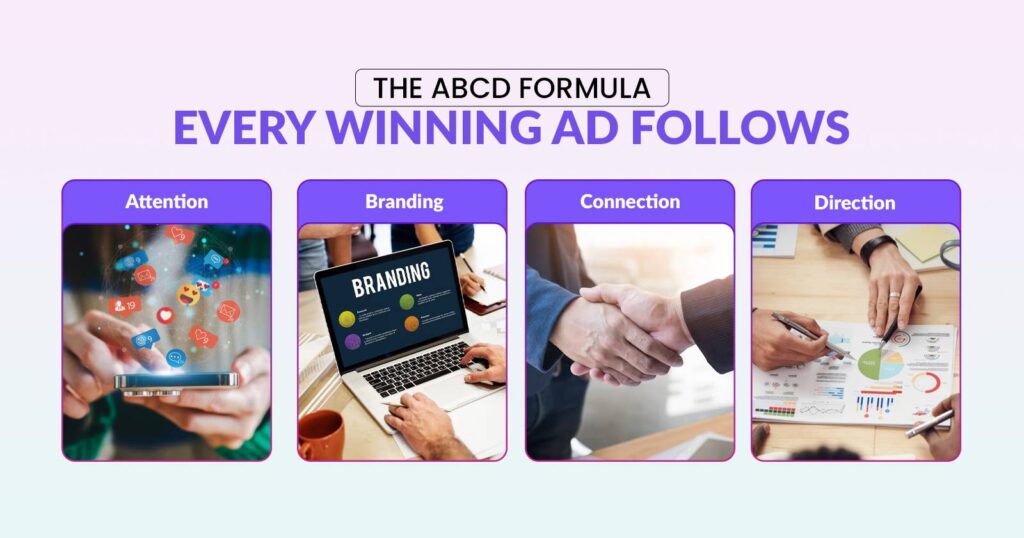
To create good YouTube ads, tell a simple story instead of just trying to sell something. First, know your audience and what they want. Good ads mix what people like with fun ideas. The best ads help viewers feel seen and understood, which helps get more people to buy.
When you plan your next ad, focus more on the words than just the pictures. AI Creative Testing now helps brands refine scripts and visuals through real data, giving you clarity on what resonates before you even publish.
Below, we’ll break down a repeatable framework used by top-performing advertisers to write and refine YouTube ads that engage from the first second and drive consistent ROI.
Understand Your Audience & Intent
Before you write a single line, know who you’re speaking to and why they’re on YouTube. Are they looking to learn, laugh, or buy? Your messaging tone changes completely based on their intent.
- Educational intent: Viewers are seeking value or solutions. Ads for SaaS tools or coaching services perform better with a helpful, guiding tone.
- Entertainment intent: For lifestyle, fashion, or travel brands, storytelling and humor create stronger recall.
- Commercial intent: These users are ready to act – they use urgency and proof to drive conversions.
A SaaS brand ad might start by showing a common problem, like video ad workflow inefficiencies, and then offer a solution. In contrast, a lifestyle ad could open with a relatable moment or emotion before naturally introducing the product.
Structure Your Script Using the ABCD Model
Google’s ABCD framework helps brands create effective YouTube ads that get results. It focuses on making your story grab attention, connect with the audience, and end with a clear action step.
| Principle | What It Means | How It Shapes Ad Writing |
|---|---|---|
| A – Attention | Hook viewers within the first 5 seconds | Start with a bold statement, visual surprise, or emotion-driven line |
| B – Branding | Make your brand visible early | Integrate product visuals or voiceovers naturally within the first few seconds |
| C – Connection | Build emotional or logical resonance | Use real stories, humor, or shared experiences to make your ad relatable |
| D – Direction | End with a strong call to action | Tell viewers exactly what to do next: “Try it free,” “Subscribe,” or “Learn more” |
When you use this structure, your ad feels purposeful from beginning to end. It looks great and is thoughtfully written to drive conversions.
Craft a Hook That Stops the Scroll
Your first five seconds will decide if viewers stay or skip your ad. To create YouTube ads that grab attention, your opening must quickly spark curiosity or emotion.
Effective Opening Examples
- Still wasting hours editing your own videos?
- What if your next ad could double conversions with one script tweak?
- You won’t believe how brands are cutting production costs in half.
Tips for Stronger Hooks
- Use emotional triggers (fear of missing out, excitement, humor)
- Create curiosity gaps that make viewers want the next line
- Present a relatable problem before offering the solution
A well-crafted hook doesn’t just grab attention, but it also sets the stage for your story to unfold naturally and keeps viewers watching until your final CTA.
Keep the Message Focused and Conversational
When you write or create YouTube ads, clarity always beats complexity. A tight, conversational script feels authentic and keeps viewers engaged till the end. Avoid long introductions or buzzwords that make your ad sound rehearsed. Instead, speak as if you’re talking to one person, not a crowd.
Here are a few simple tips to keep your message focused.
- Match pacing to intent – Fast cuts and quick lines work well for product launches or energetic brands. For tutorials or services, keep it calm and clear.
- Use natural language – Replace corporate phrases like “maximize efficiency” with “save time” or “get more done.”
- Trim filler words: Every line should move the story forward or reinforce your key point.
- Align tone with audience – Younger people like a friendly way of talking, while businesses want clear and straightforward messages.
Using a casual tone in your ad makes it feel more real, which helps keep people from skipping it.
End with a Strong Call to Action (CTA)
Even the most creative ad falls flat without a clear direction at the end. A strong CTA tells the viewer exactly what to do next and gives them a reason to act now.
Common examples include.
- Watch now to see how it works.
- Start your free trial today.
- Book your demo and get your first campaign set up free.
Pairing verbal and visual CTAs makes them twice as effective. When the message appears both on screen and through voiceover, it strengthens recall and drives action. You can also layer it with upbeat music or sound cues to give emotional weight to the moment.
The key is to make the CTA feel like a natural next step in the story, not a sales push. By ending with purpose, you close the loop and turn attention into measurable results.
Editing Your YouTube Ads for Maximum Impact
How you edit can make or break your ad. When you create YouTube ads, editing is about trimming footage and guiding emotion, pacing the story, and keeping the audience watching past the first five seconds. The right edit pulls everything together: visuals, sound, timing, and message. Good editing helps your script and visuals make the impact you want. This is true whether you are working with a small team or hiring a professional service.
Visual Flow and Pacing
The rhythm of your video helps tell your story. Use quick cuts and smooth changes to keep it exciting. For fun ads, like new product launches, move quickly to keep people interested.
If your goal is to teach or share a touching story, take your time with longer shots and gentle changes. Make your video fast for excitement and slow for feelings. Every second should matter. If it doesn’t help, just cut it out.
Sound, Music, and Subtitles
Sound is where emotion lives. A well-chosen track or sound cue can double as a recall and make your message more memorable. Use audio intentionally, upbeat music for excitement, softer tones for storytelling, or silence to emphasize a key line.
Voice clarity matters too. Keep the background music slightly under dialogue so viewers don’t miss your message. Don’t forget to use subtitles. They help everyone understand your video better. Many people watch YouTube with the sound off or in noisy places, so captions make sure your message is still clear.
Color, Branding & On-Screen Text
Your visuals should feel like your brand. Use consistent brand colors, logos, and fonts throughout the ad to strengthen recognition. On-screen text should be short, readable, strategically placed, and avoid cluttering the frame or layering multiple messages at once.
Highlight key phrases or CTAs with clean animations or bold typography. For example, if you’re promoting a discount or free trial, make it visually distinct so it stands out. Good visual branding gives your ad a professional finish without distracting from the story.
Tools and Software for Editing YouTube Ads
Choosing the right editing tool depends on your skill level and workflow. Here’s a quick comparison.
| Tool | Best For | Key Strengths |
|---|---|---|
| Adobe Premiere Pro | Professionals & Agencies | Full creative control, precise color grading, and advanced transitions |
| Final Cut Pro | Mac users & production teams | Fast rendering, intuitive timeline, clean interface |
| CapCut Pro | Solo creators & marketers | Easy templates, social-media-friendly exports, built-in AI effects |
If you want a professional team that handles everything, from editing and content repurposing to posting, ShortVids offers a complete solution. Their editors help brands and creators streamline video production without hiring in-house teams, ensuring consistency, speed, and quality at scale.
YouTube Ad Formats You Should Know Before You Create One
Before you create YouTube ads, it’s important to understand the different ad formats the platform offers. Each type has its own structure, audience interaction, and creative approach, and knowing these differences helps you write and edit with intent. Whether your goal is to boost awareness, drive clicks, or convert viewers, the format you choose influences everything from script length to pacing and visuals.
Here’s a breakdown of the most common YouTube ad formats and how to use them effectively.
Skippable In-Stream Ads
Skippable ads are the most common YouTube sales funnel as they play before, during, or after a video and can be skipped after 5 seconds. Because users can skip, your first five seconds must grab attention immediately.
Use this time to establish curiosity or relevance: speak directly to the viewer, introduce a relatable pain point, or show a striking visual. Once the viewer stays, shift into storytelling and end with a clear CTA like “Try now” or “See how it works”.
From an editing standpoint, pacing is key. Every second counts, so keep cuts tight, transitions smooth, and visuals aligned with the voiceover or dialogue.
Non-Skippable Ads
Non-skippable ads run for up to 15 seconds, giving you a guaranteed full view, but also less time to make your point. These ads work best for high-impact, brand-driven campaigns where recall matters more than detail. Since the audience must watch the entire ad, aim for a punchy message paired with bold visuals and strong sound design.
Focus on editing for visual rhythm, quick scene changes, color contrast, and energy that matches your brand tone. Every second should have a clear purpose, and your call to action (CTA) should be easy to see in the last two seconds.
Bumper Ads (6-Second Format)
Bumper ads are short, non-skippable clips lasting six seconds. Their goal is not to tell a story but to make your brand memorable instantly. Use them to retarget warm audiences, reinforce brand memory, or tease a new launch. Since the message is so short, skip narration-heavy scripts and rely on clean visuals, text overlays, and music cues.
Editing here is all about clarity. You have one line to deliver, one visual to show, and one feeling to leave behind. Think of bumper ads as visual “billboards” that support your larger YouTube campaign.
Discovery Ads (Appearing in YouTube Search)
Discovery ads show up on YouTube when you search for something or beside related videos. People choose to click on these ads because they are good for showing how to use products, teaching, or giving reviews.
The script can be more relaxed and informative since the viewer is engaged voluntarily. Keep your opening focused on what the viewer wants to learn or solve, then transition smoothly into showcasing your solution.
Editing should prioritize clear structure – easy-to-read titles, clean transitions, and consistent brand visuals. Discovery ads also benefit from captions and text overlays to emphasize product features or key stats.
YouTube Ad Formats Overview
| Format | Duration | Ideal Use Case | Editing Focus |
|---|---|---|---|
| Skippable | 15 to 60s | Storytelling + CTA | Hook & pacing |
| Non-skippable | 15s | High recall branding | Fast storytelling |
| Bumper | 6s | Awareness or retargeting | Concise CTA |
| Discovery | Variable | Product demos | Clear value prop |
Understanding these formats before you create YouTube ads helps you plan smarter, from scriptwriting to the final edit. Each format demands its own rhythm, structure, and tone, so matching your message to the right format can make the difference between a forgettable ad and one that actually converts.
Optimizing and Testing Your YouTube Ads
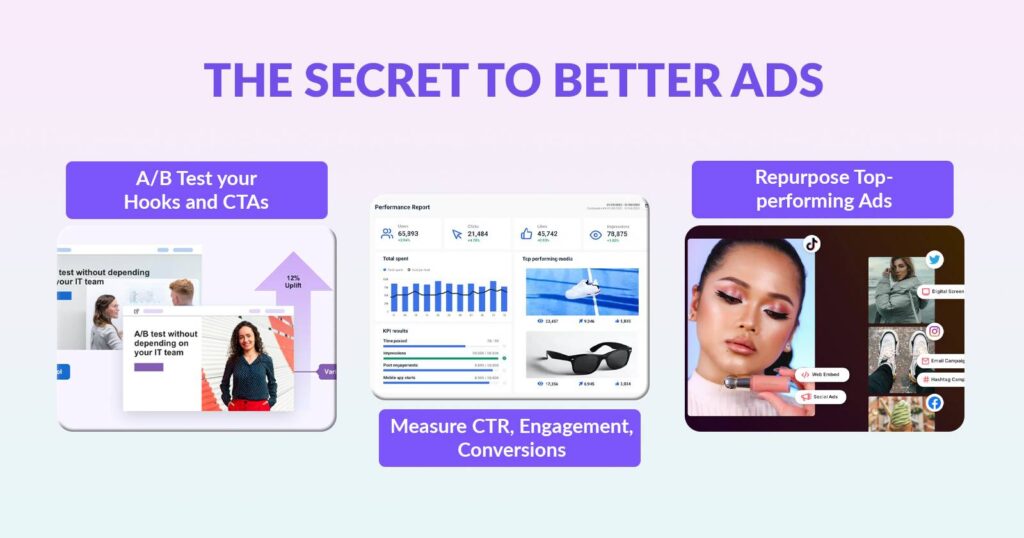
Once you create YouTube ads that perform, the next step is to optimize them through testing and performance tracking. Great ad results rarely come from a single version, and they come from analyzing what works and refining it over time. Optimization helps you understand your audience better, improve engagement, and lower ad costs while increasing conversions.
Effective testing focuses on three things – the hook, message delivery, and call-to-action. By tracking how viewers interact with each version, you can make informed adjustments that directly impact click-through rate (CTR), watch time, and better ROI.
Use A/B Testing for Hooks and CTAs
One of the simplest but most powerful ways to improve your ads is through A/B testing. YouTube’s Video Experiments tool (available in Google Ads) makes it easy to test different creative versions, whether it’s your opening hook, background music, or CTA phrasing.
For example, changing “Struggling to grow your channel?” to “Here’s why your videos aren’t working” can catch more attention. Also, trying different phrases like “Start your free trial” or “Get started today” can help more people click.
Even subtle tweaks in tone, pacing, or on-screen text can create noticeable improvements when you analyze results across campaigns.
Measure Engagement Metrics
To make smarter creative decisions, track your ad performance using metrics that reflect real engagement and conversion intent. The key KPIs include.
- Click-Through Rate (CTR) – Measures how compelling your ad is to click.
- View Rate – Shows how many users watched beyond the first few seconds.
- Engagement Rate – Tracks interactions like likes, shares, and comments.
- Cost per Conversion (CPC or CPA) – Determines how efficiently your ad drives actual actions, like sign-ups or sales.
Each of these metrics tells a different story. CTR highlights creative strength, while cost per conversion reflects campaign ROI. For deeper insights, check Google’s official Ads performance guide for recommended benchmarks and optimization techniques.
Repurpose Top-Performing Ads
If you find out which ads are the best, use them again in different ways. For example, change your popular YouTube ads into short videos for Instagram Reels, TikTok, or YouTube Shorts. This helps more people see your ads without having to make new ones.
You can easily streamline this process using content repurposing tools that automate resizing, trimming, and captioning for different platforms. This way helps you save time and keep your brand looking the same everywhere. By testing and checking what works, you can make YouTube ads that people like. You can change these ads for different audiences and new styles without having to start from the beginning.
Common Mistakes When You Write and Edit YouTube Ads
Even experienced marketers can make mistakes with YouTube ads. The problem is often a lack of focus. Ads that don’t catch attention usually don’t tell a good story or have a clear plan. Common mistakes are using too many pictures, missing a strong opening, and forgetting about people who watch on their phones.
A great YouTube ad should guide the viewer smoothly from the first frame to the final CTA. Every second needs to serve a purpose, whether it’s to inform, evoke emotion, or drive action. Below are some of the most frequent pitfalls and how to avoid them.
Common Mistakes
- Overloading visuals or information – Too many graphics, text overlays, or effects make your message hard to follow. Keep it simple and intentional.
- Weak intros with no hook – If the first five seconds don’t grab attention, most viewers will skip. Start with curiosity or a relatable problem.
- No clear CTA or branding – Viewers should instantly know who you are and what to do next, whether that’s subscribing, booking, or buying.
- Ignoring mobile optimization – Most YouTube traffic is mobile. Make sure your text, visuals, and pacing work well on small screens.
- Poor audio or pacing issues – Distracting music or uneven editing can ruin even the best visuals. Clean, consistent sound is essential.
Do’s and Don’ts When Writing and Editing YouTube Ads
A well-crafted ad is never about how much you can show – it’s about how clearly you can communicate your message in seconds.
Do’s
- Start with a strong hook that connects emotionally.
- Keep the story focused on one main message.
- Test multiple versions of your ad for performance insights.
- Use consistent colors, fonts, and logo placement for branding.
- Add captions and optimize for sound-off viewing.
Don’ts
- Don’t cram too much text or information into short ads.
- Don’t use long intros before showing value.
- Don’t rely solely on visuals as the script drives conversions.
- Don’t skip testing or a performance review.
- Don’t forget to align your tone with your audience’s intent.
How to Work with a Professional Team to Create YouTube Ads
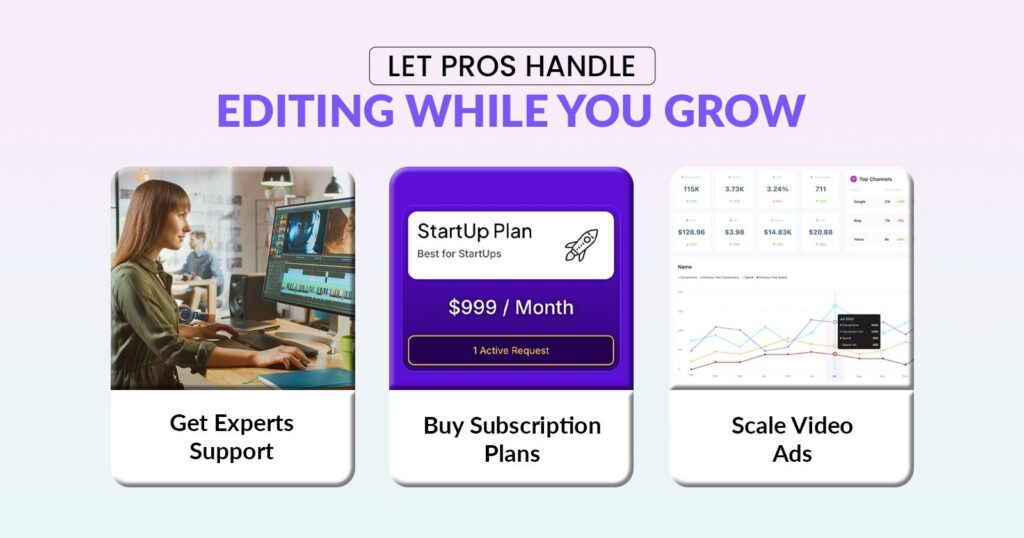
Many brands and creators work with a team to make YouTube ads that help sell their products. These teams have writers and editors who can turn ideas into ads that catch people’s attention and help sell more.
When to Outsource Writing and Editing
If you spend too much time editing, struggle to stay consistent, or miss deadlines, it’s time to hire professionals. A dedicated team can take care of scripting, storyboarding, and editing so you can focus on your strategy and growing your brand. You also gain fresh ideas, technical skills, and faster turnaround times as your campaigns expand.
Benefits of Subscription Video Editing Models
Subscription-based editing services make it easy for brands to create YouTube ads. You don’t have to hire extra help or worry about different bills. You pay one price, get quick results, and can ask for changes as many times as you want. This helps businesses make a lot of content without needing full-time workers.
ShortVids has different plans for businesses of all sizes, from new companies making their first ads to big ones with many brands. Each plan offers video editing, help managing projects, and support for making videos. This helps marketing teams stay on track and grow. ShortVids’ video production services are a streamlined solution for creating polished YouTube ads from script to final cut.
Future Trends in YouTube Ad Creation and Editing
Brands are finding new ways to create YouTube ads. As people become more selective about what they watch, it is important for brands to use new tools effectively. The future of ads will focus on personalizing them and using data to tell better stories.
AI-Assisted Scripting and Editing
AI tools are rapidly transforming how ads are written and edited. From generating script variations to suggesting scene pacing and cuts, AI is making the creative process faster and more data-driven. Brands that integrate AI editing tools can test ideas in real time and optimize videos for performance at scale.
Personalized Ads and Dynamic Storytelling
Viewers want ads that meet their specific needs. Personalized YouTube ads use data such as search history, location, and user behavior to create tailored messages and visuals. To improve engagement, advertisers will need to use dynamic video storytelling, where different versions of the same ad are shown to various audience segments.
Cross-Platform Video Ad Optimization
TikTok, Instagram Reels, and YouTube Shorts are very popular right now. Brands should create different videos for each platform because using the same video everywhere often doesn’t work well. Short videos suit social media apps, while longer videos are better for YouTube. Be flexible with your editing so you can easily create multiple versions from one shoot!
Statista says that global spending on video ads will exceed $176 billion by 2026, mainly because of YouTube and short-form platforms. Now is the best time to invest in smart and flexible video creation strategies.
| Trend | Description | Impact on Brands | How to Adapt |
|---|---|---|---|
| AI-Assisted Editing | Automates script writing, pacing, and style suggestions | Faster production, reduced costs | Combine AI tools with human oversight for creativity and accuracy |
| Personalized Ads | Uses audience data to deliver relevant ad variations | Higher engagement and retention | Build dynamic ad templates for scalable personalization |
| Dynamic Storytelling | Multiple ad versions for different user groups | Stronger brand connection | Plan scripts with modular storytelling elements |
| Cross-Platform Optimization | Editing for YouTube, TikTok, and Reels | Extended reach and consistency | Create multiple aspect ratios and cut variations from the same content |
| Real-Time Performance Tracking | Instant ad feedback via AI dashboards | Continuous improvement | Use analytics to refine scripts and visuals quickly |
Final Thoughts
To create effective YouTube ads, ensure your messaging is clear and straightforward. Focus on connecting with your audience and encouraging action, as the best ads are both creative and easy to understand.
Contact ShortVids for getting the best services, including Facebook Ads, YouTube Ads, and AI video editing, to lift your brand and agency to new heights.
FAQs About Creating YouTube Ads
Ads work better when you think about what you want to achieve. Skippable ads should be 15 to 45 seconds long, while non-skippable ads should be only 15 seconds. For ads that just want to get people’s attention, a 6-second ad can be good if the message is simple and clear.
There’s no one-size-fits-all format. Skippable in-stream ads work well for storytelling, while non-skippable and bumper ads are ideal for brand recall. Discovery ads are great for product demos or tutorials because users actively choose to watch them.
Costs vary depending on your production and editing quality. A professionally produced ad can range from $500 to $5,000+, while running ads on YouTube typically costs $0.10 to $0.30 per view, depending on audience targeting.
Yes, reports show that the average person sees between 4,000 and 10,000 ads every day across different platforms. However, most people only notice a small number of these ads.
Top editors use tools like Adobe Premiere Pro, Final Cut Pro, and DaVinci Resolve for their editing projects. If a brand wants high-quality editing without hiring someone full-time, platforms like ShortVids can take care of both editing and optimization.
Yes, it is enough for testing. A budget of $10 per day can help you understand how well your ads perform, who they reach, and how effective your creative content is. After you find which ads work best, you can slowly increase your budget to get better results.
Book a Call Today
- Fixed monthly plans starting at $999
- 24-hour turnaround time (or less) on all short-form edits
- 3-layer quality check system on every video
- No more chasing freelancers or managing editors
- Scale up to 50+ videos/month without hiring in-house
- Content team trained on platform trends, scroll-stopping hooks & storytelling
- Fully managed by professionals – you just upload & approve
- Response time: Under 1 hour (US & GCC time zones)
Cut your production costs, not your standards.

